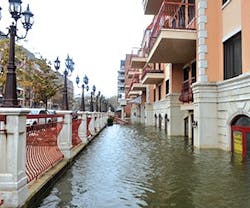Be Prepared for Post-Sandy Health and Safety Risks
The immediate danger of Superstorm Sandy is long past, but the coming warmer weather poses a challenge for hurricane-damaged buildings. Jack Nyman and Howard Wolf share advice on combating the resulting health and fire risks.
What are the main health risks posed by increasing heat and humidity in hurricane-damaged commercial buildings?
The main health risks are usually allergic reactions to chemical or biologic exposure; exposure to uncontrolled, moldy environments; and exposure to unhealthy levels of legionella bacteria from faucets and water tanks that were not properly flushed and decontaminated after services were restored.
With all the flooding and standing waters caused by the superstorm, mold will become a problem for many areas.
What types of commercial building materials are most vulnerable to microbial growth?
The most vulnerable materials are gypsum wallboard (drywall, sheetrock), soft woods (structural wood, plywood surfaces), and areas where a lot of dust has accumulated (HVAC ductwork, fireproof coatings, open framing, grout lines in masonry block and tiles).
Storage rooms where paper and cardboard are stored are a huge problem, primarily because the items usually sit and fester while decisions are made on salvageability and disposal.
What effects could lingering storm damage combined with spring/summer weather have on mechanical building systems?
Mechanical systems, such as HVAC, electrical, and plumbing, are particularly vulnerable in their own way.
HVAC: Ductwork, especially insulated, absorbs moisture quickly, releases it slowly, and contains substantial food sources for microbes. Air handler components are suspect. Motors have to be replaced, bearings repacked, squirrel cages cleaned or re-built, and gaskets and vibration dampeners replaced.
Electrical: Wiring can wick water for several feet above the water line. Switch gear can fail and the main power detail will not properly megger test out, creating “dirty power.”
Plumbing: These systems are usually closed and relatively immune to widespread damage, but valves, steam heads, and pump motors need to be inspected and/or replaced.
How can you tell if your electrical equipment is damaged badly enough to pose a fire risk? What signs (if any) would indicate that you should repair equipment instead of replacing it?
Electrical is something that a building owner should not mess with. Latent moisture from incomplete drying, as well as salt remaining on the wires and equipment, will cause electrical systems to overheat. This overheating may occur slow enough to prevent fault controls from switching the power off.
The rules of thumb for electrical are easy: if it is wet, replace it. If it is contaminated with salts or is sitting below the water line, replace it. If wires are wet, cut the wire at least 2 feet past where moisture was last detected.
Jack Nyman is the director of Baruch College’s Steven L. Newman Real Estate Institute. He has served as vice chair of the executive board of the Urban Green Council since 2009. Howard Wolf is principal of HW3 Consulting Group.
